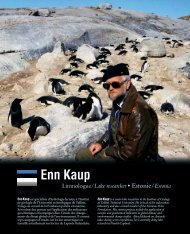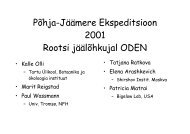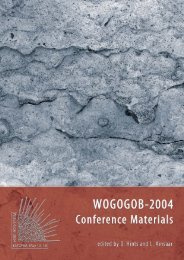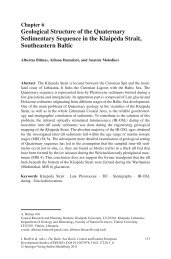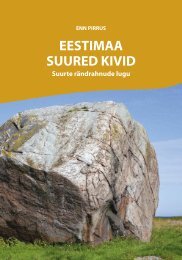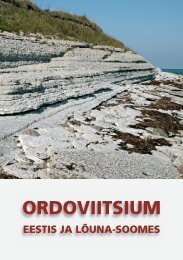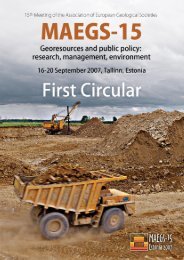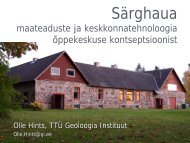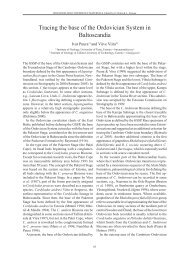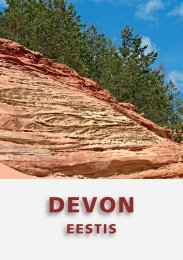Excursion Guidebook - Geoloogia Instituut
Excursion Guidebook - Geoloogia Instituut
Excursion Guidebook - Geoloogia Instituut
Create successful ePaper yourself
Turn your PDF publications into a flip-book with our unique Google optimized e-Paper software.
10 th International Symposium on Fossil Cnidaria and Porifera. <strong>Excursion</strong> B2: Field GuideStromatoporoidsIn the Ordovician and Silurian strata of Estonia, 88valied species of stromatoporoids have been described(Rosen 1867, Nicholson 1886a,b, Riabinin1951, Nestor 1960, 1964, 1966). The full list of thespecies, belonging to 26 genera and 16 families, andrepresenting all orders of stromatoporoids exceptfine-cylindrical amphiporids, was published recently(Nestor 1990d). Stromatoporoids are continuouslypresent in all regional stages of Estonia beginningfrom the Lower Ashgill (Vormsi Stage) and endingwith the Lower Pridoli (Kaugatuma Stage). However,some earliest representatives of stromatoporoids(Stromatocerium canadense and S. sakuense) occurin the Middle Caradoc (Oandu Stage) already. Shortergaps in the distribution, explained with unfavourableecological conditions or local stratigraphical hiatuses,occur at the Llandovery/Wenlock and Wenlock/Ludlowboundaries.Stromatoporoids appeared in the Estonian sequencelater than in North America, North China or Australiawhere the earliest indubitable stromatoporoids havebeen recorded from the Llanvirn - Llandeilo strata already.It has been explained with the location of theBaltica Continent in the southern temperate climatezone until the Ashgill time when it migrated finallyinto the equatorial belt (Webby 1980).In the Ordovician of Estonia, stromatoporoids arerare, except its topmost part - the Porkuni Stage. Afew species of the most primitive, vesicular stromatoporoids(Order Labechiida) have been recorded fromthe Oandu (Stromatocerium), Pirgu (Cystostroma)and Porkuni (Pacystylostroma) stages. Plumatalinia,a problematic intermediate form between labechiidaeand reticulate stromatoporoids (Actinostromatidae),occurs in the Pirgu Stage (Fig. 15). In the latest Ordovician,representatives of the sublaminate stromatoporoids(Order Clathrodictyida) became rather common:Clathrodictyon appeared during the Vormsi Ageand Ecclimadictyon in the Porkuni Age.In the Llandovery, clathrodictyids flourished.Clathrodictyon Nich. et Murie and EcclimadictyonNestor became dominating genera. They formed morethan 80% of stromatoporoid specimens. Labechiids(Pachystylostroma, Forolinia, Rosenella and Labechia)were the second abundant group. During theLlandovery, the first representatives of several familiesappeared in the Estonian sequence. Thus, duringRaikküla time, Intexodictyon - the earliest knownrepresentative of the Family Atelodictyidae (Fig. 15),and Plectostroma, the first certain representative ofthe Order Actinostromatida, made their appearance.During the Adavere Age, Petridiostroma was addedamong clathrodictyids as the most ancient representativeof the Family Gerronostromatidae. At the sametime, a very peculiar form “Stromatopora” elegansRosen (=Pachystroma) appeared, showing the closestaffinities to the Family Pseudolabechiidae. Thus,during the Llandovery, the first genuine laminatestromatoporoids (Atelodictyidae and Gerronostromatidae)and different branches of reticulate stromatoporoids(Actinostromatidae, Pseudolabechiidae) weregradually added to the prevailing fauna of the sublaminateand vesicular stromatoporoids.During the Wenlock, the enrichment and diversificationof the stromatoporoid fauna continued.In Jaani time, the first known microreticulate stromatoporoidDensastroma appeared. It belongedto the family Densastromatidae and played an importantrole later in the Silurian. At the same time,Stromatopora appeared in the Estonian sequence,being one of the earliest representatives of the OrderStromatoporida, i.e. stromatoporoids with irregularlyamalgamated skeletal elements. Simplexodictyonvalidum Nestor, an early representative of the tripartite-laminatedstromatoporoids (Order Stromatoporellida),has been recorded from the Maasi bedsof the Jaagarahu Stage. Vikingia tenuis (Nestor) wasthe main frame builder in the Jaagarahu reefs (Vilsandibeds); it may be treated as a possible ancestorof the Order Syringostromatida with clinoreticulatemicrostructure of vertical skeletal elements (Nestor1994). During the Wenlock the role of clathrodictyidsdecreased considerably; labechiids have not beenrecorded from Estonia.During the Early Ludlow (Paadla Age), the diversityof the stromatoporoid fauna reached its maximum(13 genera from 12 families) in Estonia. In differenttaxonomical branches new elements were added, e.g.Lophiostroma among labechiids, Plexodictyon amongclathrodictyids, Pseudolabechia in Actinostromatida,Syringostromella among stromatoporids, and Parallelostroma- the first representative of the Order Syringostromatidain the Estonian sequence. However,representatives of all the above-mentioned genera areknown from somewhat earlier strata in other regions(Nestor 1994). In the Late Ludlow (Kuressaare Age)and Early Pridoli (Kaugatuma Age), the diversity ofstromatoporoid assemblages decreased considerablydue to an increase in the clay content of sediments andbad exposure of the corresponding strata. Stromatoporoidshave not yet been recorded from the SilurianOhesaare Stage.The above leads to the conclusion that favourableclimatic conditions for constant colonization of theEstonian area by stromatoporoids were establishedduring the Ashgill. The beginning of the Silurian26





